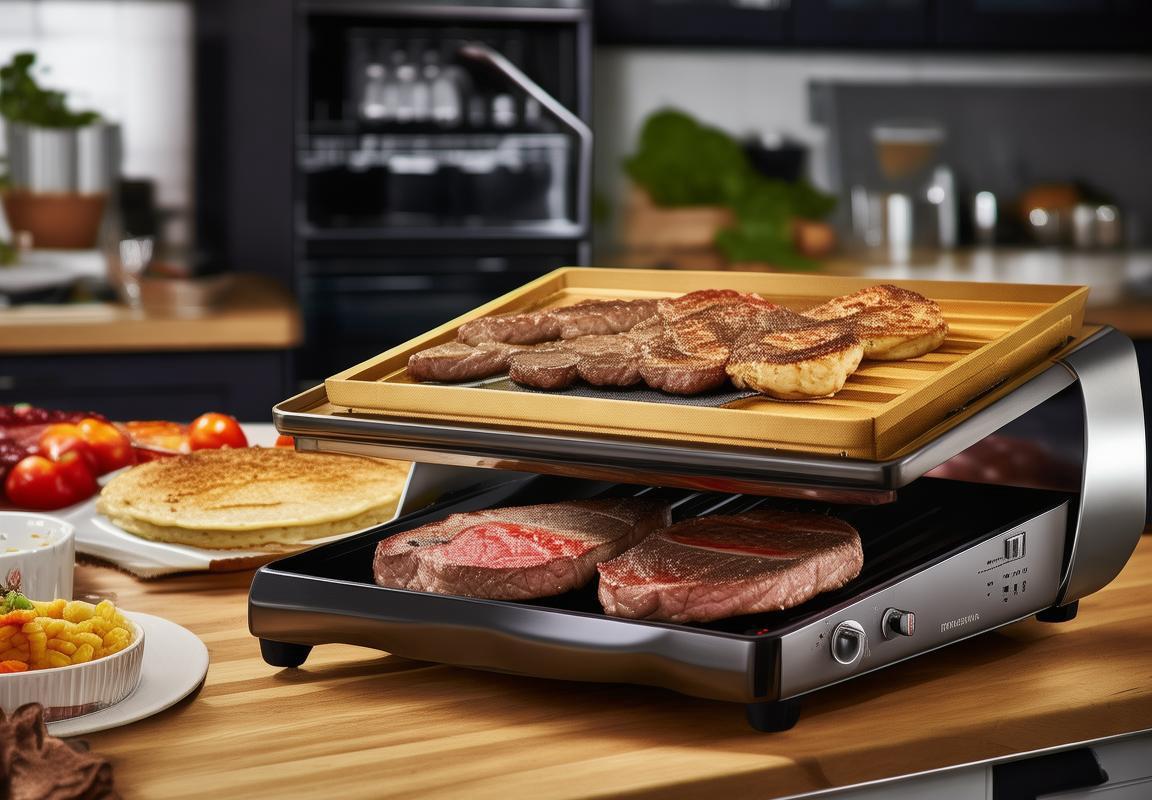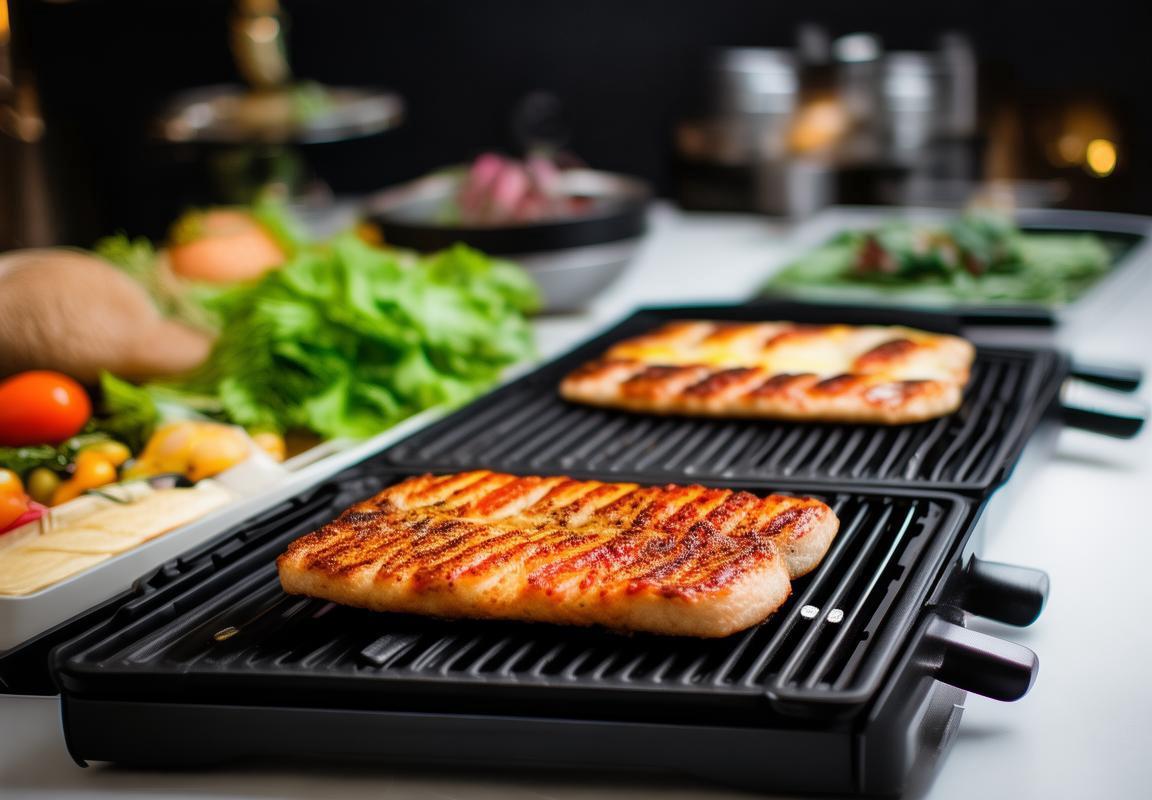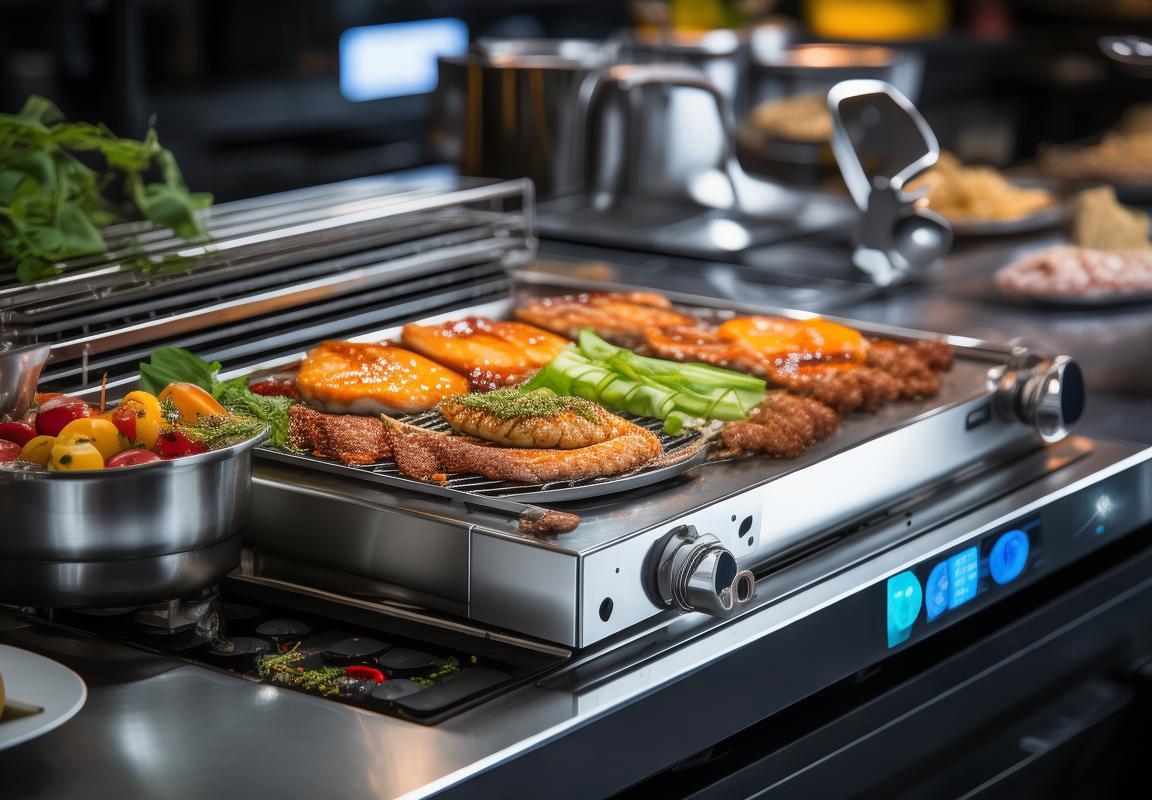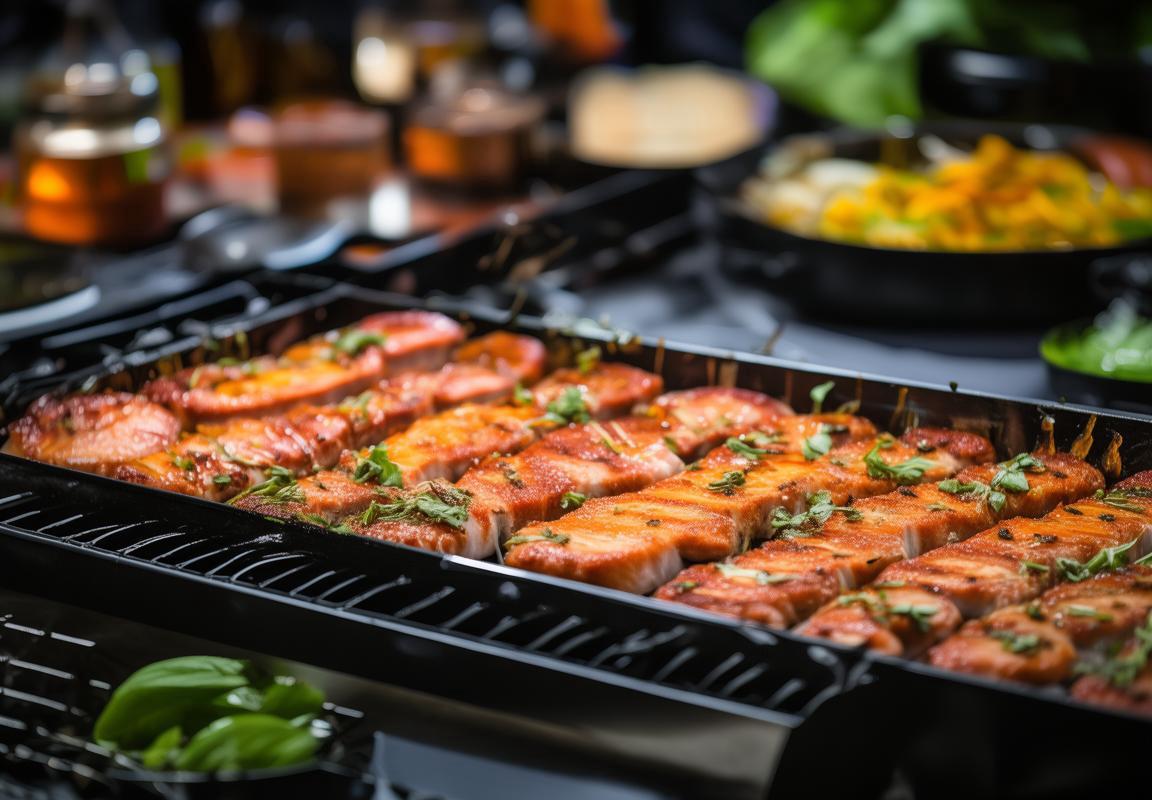As the culinary landscape evolves, so does the appliance industry, with contact grills emerging as a favorite among consumers for their convenience and versatility. This shift has sparked a surge in demand, leading to a thriving market ripe with opportunities for Original Equipment Manufacturers (OEMs) looking to tap into this trend. Join us as we delve into the intricacies of the contact grill market, exploring the dynamics that are shaping this sector and the future outlook that promises both challenges and rewards.
The Rise of Contact Grills in the Western Market
The surge in the popularity of contact grills has been a fascinating phenomenon in the Western markets, particularly in Europe and North America. Once a niche product, these compact grills have now become a staple in many homes, appealing to both seasoned chefs and novices alike. This rise can be attributed to several key factors that have reshaped the landscape of the cooking appliance industry.
Cooking enthusiasts are increasingly seeking convenience without sacrificing quality. Contact grills offer a perfect solution for those looking to achieve restaurant-quality searing on their countertop. The ease of use, coupled with the minimal cleanup, has made them a must-have for busy professionals and families. Moreover, the versatility of these grills, which can handle everything from steaks to pancakes, has expanded their appeal beyond the grill aficionados.
As health and wellness continue to dominate consumer concerns, contact grills have stepped into the spotlight. They provide a healthier alternative to deep-frying, offering a lower-fat option for cooking without the need for excessive oil. This health-conscious trend has significantly boosted the demand for contact grills, especially as consumers look to incorporate more balanced meals into their diet.
The technological advancements in contact grills have also played a crucial role in their popularity. Modern grills now come with features like adjustable temperature controls, non-stick surfaces, and even smokeless cooking capabilities. These innovations have not only made the grilling experience more enjoyable but also more precise, ensuring that every dish is cooked to perfection.
The Western market has seen a rise in home entertaining and outdoor dining. Contact grills are a fantastic addition to any home party setup, allowing guests to grill their own meats and veggies, fostering a more interactive and enjoyable experience. This social aspect has contributed to the increased sales of contact grills, as they become a centerpiece for gatherings.
Branding and marketing strategies have also been instrumental in the growth of contact grills. Manufacturers have tapped into the desire for unique and high-quality kitchenware, positioning their contact grills as both stylish and functional. The use of high-quality materials and sleek designs has helped create a perception of premium value, encouraging consumers to make the investment.
In the retail sector, contact grills have seen significant growth in online sales. The convenience of shopping from home, coupled with the ease of comparing features and prices, has made online shopping a preferred option for many. This shift has opened up new markets for contact grill suppliers, as they can now reach a wider audience.
Looking at the suppliers, the market has seen a variety of players, from well-established kitchen appliance companies to niche startups. These suppliers have catered to different segments of the market, offering a range of contact grills that cater to different budgets and preferences. From entry-level models to high-end, feature-rich units, there’s a contact grill for everyone.
As the demand for contact grills continues to grow, manufacturers have started focusing on sustainability and environmental concerns. The use of energy-efficient designs and eco-friendly materials has become a priority for many, appealing to consumers who are environmentally conscious.
In conclusion, the rise of contact grills in the Western market is a testament to changing consumer preferences and technological advancements. From convenience to health consciousness, these grills have found a niche that resonates with the modern consumer. As suppliers and OEMs continue to innovate and adapt to the market needs, it’s clear that contact grills will remain a popular choice in the cooking appliance landscape.

Understanding the Contact Grill Market Dynamics
The contact grill market in the Western world has experienced a significant surge in popularity, driven by a combination of lifestyle changes, technological advancements, and consumer preferences. This dynamic landscape is shaped by various factors that have collectively contributed to the rise of contact grills as a preferred cooking method.
One of the primary drivers behind this growth is the increasing demand for healthier cooking alternatives. With a growing awareness of the health benefits of grilling over traditional cooking methods like frying, consumers are turning to contact grills that offer a quick and easy way to prepare meals with minimal oil. This shift towards healthier living is particularly pronounced among health-conscious individuals and families.
Moreover, the convenience factor cannot be overlooked. Contact grills are compact, easy to use, and require minimal cleanup. They fit seamlessly into the fast-paced lives of many Western consumers, who value efficiency and time-saving appliances. The ability to cook a variety of foods, from meats to vegetables, all on one surface, adds to their appeal.
Innovation in design and technology has also played a crucial role in the market’s dynamics. Modern contact grills often come with features like adjustable heat settings, non-stick surfaces, and built-in timers, making them more versatile and user-friendly. These advancements not only enhance the cooking experience but also extend the life of the appliance by reducing wear and tear.
The rise of the outdoor cooking culture in Western countries has also had a substantial impact on the contact grill market. As people spend more time entertaining outdoors, the need for portable and efficient cooking solutions has increased. Contact grills are perfectly suited for these settings, offering a convenient way to cook on patios, balconies, and camping trips.
Another dynamic factor is the influence of culinary trends. The popularity of gourmet and international cuisine has led to a demand for specialized cooking tools that can replicate the flavors and textures of different cooking techniques. Contact grills, with their ability to achieve a perfect sear and grill marks, have become a staple in many home kitchens, emulating the high-end restaurant experience.
Retail distribution channels have also evolved, contributing to the market’s growth. Online sales have seen a dramatic rise, with e-commerce platforms offering a wide range of contact grills at competitive prices. This accessibility has made it easier for consumers to discover new brands and models, further fueling market expansion.
The competitive landscape is another key aspect of the contact grill market dynamics. With numerous brands and models available, manufacturers are constantly innovating to stand out. This competition has led to a greater variety of features and designs, catering to different consumer needs and preferences. From budget-friendly options to high-end models with premium materials, there is something for every segment of the market.
In terms of demographics, the contact grill market is not limited to a specific age group or income level. It appeals to a broad audience, including young professionals, families, and retirees. This wide appeal is a testament to the versatility and convenience that contact grills offer.
The market’s growth is also influenced by the rise of social media and influencer marketing. As consumers seek inspiration for their cooking endeavors, they turn to social platforms to find recipes and product reviews. Influencers often showcase their favorite contact grill models, further driving consumer interest and sales.
Lastly, sustainability and environmental concerns have become more prevalent. As consumers become more aware of the impact of their purchasing decisions on the planet, they are increasingly looking for eco-friendly products. Contact grills, being energy-efficient and producing less waste compared to traditional cooking methods, align with these values.
In conclusion, the contact grill market in the Western world is dynamic and multifaceted, with a variety of factors contributing to its growth. From health and convenience to technological innovation and cultural trends, the market continues to evolve, offering a wealth of opportunities for both manufacturers and consumers.

Contact Grill Supplier Profiles
In the bustling world of kitchen appliances, contact grills have emerged as a favorite among consumers seeking convenience and quality. Here’s a glimpse into the profiles of some of the key suppliers shaping the contact grill market.
-
BrevilleWith a reputation for innovation and quality, Breville has become a household name in the appliance industry. Their contact grills are no exception, offering sleek designs and advanced features that cater to both casual cooks and culinary enthusiasts. Breville’s commitment to durability and performance has solidified their position as a leading supplier in the market.
-
CuisinartCuisinart, known for its wide range of kitchen gadgets, has made a significant mark in the contact grill sector. Their grills are praised for their ease of use, affordability, and consistent performance. Cuisinart’s diverse product line caters to different consumer needs, from compact models for small kitchens to larger, more robust grills for outdoor cooking enthusiasts.
-
George ForemanThe George Foreman brand is synonymous with contact grills, thanks to its iconic flat-top grills that have been around for decades. The brand’s reputation for healthy cooking, thanks to its ability to cook with little to no oil, has made it a favorite among health-conscious consumers. George Foreman continues to innovate, offering a variety of models that cater to different cooking preferences and budgets.
-
Hamilton BeachHamilton Beach has made a name for itself by providing practical and affordable kitchen appliances. Their contact grills are no different, offering a balance between quality and price. Known for their user-friendly features and reliable performance, Hamilton Beach grills are a go-to choice for many home cooks.
-
T-falT-fal, a well-respected name in cookware, has extended its reach into the contact grill market. Their grills are recognized for their non-stick surfaces, which make cooking and cleaning a breeze. T-fal’s commitment to providing high-quality, easy-to-use appliances has earned them a loyal customer base.
-
Breville Barista ExpressWhile primarily known for their coffee makers, Breville has also ventured into the contact grill market with the Barista Express. This model combines the brand’s expertise in coffee with the convenience of a contact grill, offering a unique product that appeals to coffee aficionados and grill enthusiasts alike.
-
Chef’s ChoiceChef’s Choice has made a name for itself by offering high-quality kitchen tools and gadgets. Their contact grills are no different, focusing on precision and performance. Chef’s Choice grills are often favored by professional chefs and serious home cooks who demand the best in cooking technology.
-
Black & DeckerBlack & Decker, a brand known for its power tools, has also entered the kitchen appliance market. Their contact grills are designed with convenience in mind, offering a range of features that make grilling easy and enjoyable. Black & Decker’s commitment to affordability has made their grills accessible to a wide audience.
These supplier profiles highlight the diversity and innovation within the contact grill market. Each brand brings its own unique strengths and offerings, contributing to the dynamic growth of this popular kitchen appliance category.

OEM Opportunities in the Contact Grill Sector
In the realm of kitchen appliances, the contact grill sector has emerged as a lucrative area for Original Equipment Manufacturers (OEMs). With the growing popularity of outdoor cooking and health-conscious consumers seeking convenient cooking solutions, there are several opportunities that OEMs can capitalize on within this dynamic market.
The first opportunity lies in the customization of contact grill designs. As consumer preferences vary widely, OEMs can cater to these diverse tastes by offering a range of grill designs, from sleek, modern models to classic, traditional styles. This allows for a broader market reach and the potential to attract niche markets.
Secondly, the integration of smart technology presents a significant opportunity for OEMs. With the increasing trend towards smart kitchens, incorporating features like Bluetooth connectivity, temperature control, and recipe suggestions can set a brand apart in a crowded market. This not only enhances user experience but also opens up new avenues for data-driven marketing and customer engagement.
Thirdly, the demand for eco-friendly and sustainable products is on the rise. OEMs can tap into this opportunity by focusing on the development of contact grills made from recycled materials or with energy-efficient designs. This approach not only aligns with consumer values but can also lead to certifications and endorsements that boost brand credibility.
Fourthly, there’s a niche market for specialized contact grills that cater to specific cooking styles or dietary preferences. For instance, grills designed for low-carb or gluten-free diets, or those that are particularly suited for grilling delicate fish or vegetables, offer unique selling points. OEMs can innovate in this area to capture a dedicated customer base.
Fifthly, the global market for contact grills is expanding rapidly, offering OEMs the chance to enter new geographical markets. By adapting their products to meet local regulations and preferences, OEMs can establish a strong presence in emerging regions and capitalize on the growing demand for contact grills in these areas.
Sixthly, there’s an opportunity for OEMs to create value-added services around their contact grill products. This could include offering extended warranties, maintenance packages, or even subscription services that provide regular updates and accessories. Such services can enhance customer loyalty and create additional revenue streams.
Seventhly, the collaboration with ingredient suppliers and foodservice providers can create synergistic opportunities. OEMs can work with these partners to develop contact grills that are specifically designed for commercial use, with features that make them more durable and easier to clean. This can open up a new market segment for high-volume sales.
Eighthly, the opportunity to innovate in terms of materials and construction is vast. For example, using advanced materials that offer better heat distribution and retention can lead to improved cooking performance and energy efficiency. OEMs can invest in research and development to explore these possibilities and gain a competitive edge.
Ninthly, the rise of social media and influencer marketing has created a platform for OEMs to showcase their contact grill products. By leveraging these platforms, OEMs can reach a wider audience and create buzz around new features or product lines, potentially leading to increased sales.
Finally, the opportunity to engage in continuous product improvement is a key advantage for OEMs. By actively seeking feedback from customers and staying abreast of industry trends, OEMs can refine their products over time, ensuring they remain relevant and competitive in the market.
In summary, the contact grill sector offers a wealth of opportunities for OEMs, from design customization and smart technology integration to eco-friendly initiatives and global market expansion. By capitalizing on these opportunities, OEMs can not only grow their market share but also contribute to the evolving landscape of kitchen appliances.

Market Trends and Future Outlook
The contact grill sector has been witnessing a surge in popularity, and this trend doesn’t seem to be slowing down. Let’s delve into some of the key market trends shaping the future of this industry.
The rise of health-conscious consumers has spurred the demand for healthier cooking methods, which contact grills provide. These appliances not only help in reducing oil usage but also lock in more of the natural flavors and nutrients of the food. This shift towards healthier lifestyles is expected to continue driving market growth.
Innovation is a cornerstone of the contact grill sector. Brands are constantly looking to improve their products with features like adjustable heat settings, non-stick surfaces, and integrated temperature control. Smart grills that can be controlled via apps are also becoming more prevalent, reflecting the broader trend of smart home appliances.
The integration of technology isn’t just limited to smart features; it’s also extending to the manufacturing process. Contact grill suppliers are increasingly investing in automation and AI to enhance efficiency and quality. This not only allows for faster production but also ensures consistency in product design and performance.
Eco-friendly materials are gaining traction, with more suppliers exploring sustainable options for the construction of their contact grills. Biodegradable plastics and recycled metals are being used more frequently, not just to reduce environmental impact but also to appeal to environmentally conscious consumers.
The contact grill market is seeing a notable expansion into new markets, particularly in Asia and South America. As these regions continue to develop, their populations are becoming more health-aware and affluent, leading to a growing interest in high-quality kitchen appliances.
The rise of the gig economy and e-commerce has also influenced the contact grill sector. Consumers are looking for convenience, and online shopping has made it easier than ever to purchase these products. This has led to an increase in direct-to-consumer (DTC) sales, which are expected to grow even further as the digital landscape continues to evolve.
Another significant trend is the customization of contact grills. Consumers are not only looking for variety in features but also in the design of the appliance. Customizable options, such as color choices and add-on accessories, are becoming more common, catering to individual preferences and lifestyles.
The future of the contact grill market is also poised to be influenced by regulatory changes. As health and safety standards evolve, manufacturers will need to ensure their products meet new guidelines. This could include certifications for lower emissions, safer materials, and energy efficiency.
The emergence of hybrid grilling appliances that combine contact grilling with other cooking methods, like infrared or convection, is another exciting trend. These multi-functional appliances offer versatility and are likely to attract consumers who are interested in a broader range of cooking possibilities.
Lastly, the impact of social media and influencer marketing cannot be overlooked. High-quality images and videos of contact grills in use, shared by influencers, can significantly boost brand awareness and sales. As the digital age progresses, the importance of online presence and social media engagement will only increase.
In summary, the contact grill sector is poised for continued growth, driven by health-conscious consumers, technological advancements, and a focus on sustainability. As the market evolves, so too will the opportunities for both established brands and new entrants. The key will be to stay attuned to these trends and adapt accordingly.

Choosing the Right Contact Grill Supplier
Understanding the intricacies of selecting the right contact grill supplier is a pivotal decision for any OEM looking to enter or expand in the market. Here’s a deep dive into the factors to consider:
-
Quality Assurance and Manufacturing StandardsQuality is non-negotiable in the contact grill market. A reliable supplier must adhere to stringent quality control measures to ensure that their products meet industry standards. Look for suppliers with certifications like ISO 9001 or ISO 13485, which indicate a commitment to quality and continuous improvement.
-
Customization and FlexibilityEach OEM has unique product requirements and design preferences. A supplier that offers customization services can tailor the contact grills to meet specific specifications. This includes adjustable heat settings, non-stick surfaces, and innovative designs. The ability to provide samples for approval before mass production is also a crucial factor.
-
Innovation and Product DevelopmentThe contact grill market is dynamic, with constant advancements in technology and design. A supplier that invests in research and development (R&D) can offer cutting-edge products. This could mean incorporating new materials, energy-saving technologies, or smart features that enhance user experience.
-
Production Capacity and ScalabilityAs an OEM, you’ll need a supplier with the capacity to handle your production volume, whether it’s a small batch for a pilot program or large-scale production for a mainstream launch. Ensure that the supplier has the infrastructure and workforce to scale up as your business grows.
-
Supply Chain Stability and ReliabilityThe supply chain is a delicate balance of materials, components, and logistics. A supplier with a stable supply chain minimizes disruptions and ensures consistent delivery times. Evaluate their ability to manage inventory, source raw materials, and handle transportation efficiently.
-
Cost-Effective SolutionsWhile quality is paramount, cost-effectiveness is also a critical factor. A supplier that offers competitive pricing without compromising on quality can help maintain your profit margins. However, it’s essential to balance cost with the value you receive, including quality, service, and reliability.
-
Customer Service and SupportA good supplier provides excellent customer service throughout the partnership. This includes responsive communication, technical support, and after-sales service. A supplier that values your business will be there to address any issues promptly and efficiently.
-
Compliance with RegulationsContact grills are subject to various safety and regulatory standards, depending on the region. Your supplier must comply with all relevant laws, such as electrical safety standards, flame retardancy requirements, and food safety regulations. Ensure they have a robust compliance process in place.
-
Environmental ResponsibilityIn today’s market, environmental considerations are more important than ever. Look for suppliers who prioritize sustainability in their operations. This could include using eco-friendly materials, reducing waste, and implementing green logistics practices.
-
Long-Term Partnership PotentialBuilding a long-term relationship with a supplier can offer numerous benefits, from preferential pricing to exclusive product lines. Assess whether the supplier is interested in fostering a long-term partnership and whether they align with your business values and goals.
When choosing a contact grill supplier, it’s also wise to consider:
- Their track record in the industry and reputation among other OEMs.
- The range of products they offer, ensuring they can support a variety of needs.
- Their ability to provide marketing and branding support to help differentiate your products in the market.
- The level of transparency in their business practices, including pricing and production timelines.
By thoroughly evaluating these aspects, you can make an informed decision that aligns with your business objectives and sets the stage for a successful venture in the contact grill sector.

Case Studies: Successful OEM Partnerships
In the ever-evolving landscape of the contact grill sector, successful OEM partnerships have become a testament to the power of collaboration and innovation. Let’s delve into a few case studies that highlight these fruitful alliances.
The partnership between GrillGuru and InnovateGrillTech saw GrillGuru leverage InnovateGrillTech’s cutting-edge heat distribution technology to enhance their contact grill line. This integration resulted in a product that not only cooked more evenly but also had a sleeker design that appealed to consumers seeking both functionality and aesthetics.
GrillGuru’s decision to team up with InnovateGrillTech was driven by a desire to differentiate their brand in a crowded market. The OEM collaboration allowed GrillGuru to bring to market a contact grill that stood out for its precision cooking capabilities, a feature that was a direct outcome of InnovateGrillTech’s expertise.
On the other side of the partnership, InnovateGrillTech benefited from the exposure to a larger consumer base. Their technology was integrated into GrillGuru’s premium line, which helped them gain recognition in the contact grill industry. The success of this partnership can be measured by the increased sales figures and positive feedback from customers who appreciated the improved cooking performance.
Another case in point is the collaboration between SmartCookGrills and PowerHeat Solutions. SmartCookGrills was looking to expand its range of contact grills and needed a reliable supplier of high-quality heating elements. They found PowerHeat Solutions, a company specializing in custom heating solutions for cooking appliances.
The partnership with PowerHeat Solutions enabled SmartCookGrills to offer a range of contact grills that could achieve precise temperature control, a critical factor for cooking a variety of foods to perfection. PowerHeat Solutions’ expertise in creating heating elements that were durable and energy-efficient was a game-changer for SmartCookGrills.
The synergy between the two companies resulted in SmartCookGrills’ products becoming the go-to choice for home chefs and culinary professionals alike. PowerHeat Solutions, in turn, expanded its portfolio and reputation as a preferred supplier in the cooking appliance industry.
Yet another successful partnership involves EcoGrill Solutions and GreenTech Components. EcoGrill Solutions, known for its eco-friendly appliances, was seeking a supplier that could provide sustainable materials for their contact grill line. They partnered with GreenTech Components, a company committed to creating eco-friendly materials for a range of industries.
The partnership allowed EcoGrill Solutions to integrate biodegradable components into their contact grills, aligning with their brand ethos and attracting environmentally conscious consumers. GreenTech Components, on the other hand, gained a valuable partner that validated the use of their materials in high-end cooking appliances.
This collaboration also led to innovative product development, with EcoGrill Solutions introducing the first line of contact grills that were completely free of harmful plastics. The positive response from the market demonstrated that sustainability can be a strong selling point in the contact grill sector.
In each of these case studies, the successful OEM partnerships were built on a foundation of mutual respect and shared goals. The suppliers brought their specialized knowledge and technological prowess, while the OEMs leveraged these resources to enhance their product offerings and meet the demands of a changing market.
These partnerships have not only driven innovation but have also opened doors to new markets and customer segments. By combining the strengths of each entity, these alliances have set the stage for future growth and have become models for other companies looking to establish their own successful OEM relationships in the contact grill sector.

Conclusion
In reflecting on the journey through the contact grill market, one cannot help but notice the transformative impact it has had on the way we approach cooking. From the evolution of the contact grill itself to the partnerships that have fueled its growth, there are several key takeaways that underscore the significance of this sector.
The innovation in contact grill technology has been nothing short of remarkable. With advancements like non-stick coatings, adjustable heat settings, and sleeker designs, these appliances have become more user-friendly and versatile. The ability to sear, grill, and lock in flavors with ease has made them a staple in many kitchens, both professional and domestic.
The market dynamics have been shaped by consumer preferences shifting towards healthier cooking methods. As people become more health-conscious, the demand for contact grills that offer healthier alternatives to traditional grilling methods has surged. This shift has also led to the development of eco-friendly materials and energy-efficient designs, reflecting a broader trend in the appliance industry.
Partnerships between Original Equipment Manufacturers (OEMs) and suppliers have been instrumental in driving the sector forward. These collaborations have not only led to the creation of new products but have also enhanced the overall quality and variety available to consumers. The ability to customize and offer a range of contact grills to cater to different market segments has been a game-changer.
The integration of smart technology into contact grills is another trend worth noting. With the rise of the Internet of Things (IoT), these appliances are now capable of connecting to smartphones and other devices, allowing users to monitor and control their grilling sessions remotely. This added convenience and control has opened up new possibilities for both manufacturers and consumers.
The success stories of OEM partnerships highlight the power of innovation and strategic alliances. For instance, one notable partnership between a leading OEM and a specialized contact grill supplier resulted in a groundbreaking product that combined advanced technology with ergonomic design. This collaboration not only increased market share but also set new standards for the industry.
Looking ahead, the future of the contact grill market appears promising. With the continued emphasis on health and wellness, the demand for contact grills is expected to remain strong. Additionally, the potential for further technological integration suggests that we may see even more sophisticated and efficient models in the coming years.
Another exciting development is the expansion into new markets. As the popularity of contact grills grows globally, OEMs are exploring opportunities in regions where traditional grilling methods are the norm. By adapting their products to suit local tastes and preferences, these companies are poised to tap into untapped markets and expand their customer base.
The importance of sustainability cannot be overstated. As environmental concerns continue to rise, the contact grill industry is increasingly focusing on reducing its carbon footprint. This includes the use of sustainable materials, energy-efficient production processes, and eco-friendly packaging. By addressing these issues, OEMs are not only contributing to a greener planet but also appealing to a growing segment of environmentally conscious consumers.
The competitive landscape of the contact grill market is also evolving. As new players enter the scene, the industry is becoming more diverse and dynamic. This competition, however, has fueled innovation, leading to continuous improvements in product design, performance, and customer satisfaction.
In conclusion, the contact grill market is a testament to the power of innovation, strategic partnerships, and market trends. From technological advancements to the shift towards healthier living, this sector has demonstrated its resilience and adaptability. As we move forward, it’s clear that the contact grill industry will continue to shape the future of cooking, bringing with it new possibilities and experiences for consumers worldwide.